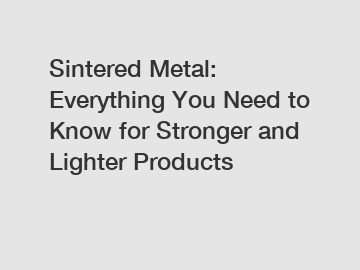Sintered Metal: Everything You Need to Know for Stronger and Lighter Products
Sintered metal is a popular choice for creating stronger and lighter products due to its unique manufacturing process. Here's everything you need to know about sintered metal and how it can benefit your products.
**Understanding Sintered Metal**.
Sintered metal is created by compacting and heating metal powders at a high temperature below their melting point. This process allows the metal particles to bond together, forming a solid structure with high strength and durability. Sintered metal is known for its excellent mechanical properties, including high tensile strength and wear resistance.

**Benefits of Sintered Metal**.
1. **Strength**: Sintered metal products have high strength and density, making them ideal for applications requiring structural integrity and reliability.
2. **Lightweight**: Despite their strength, sintered metal products are lightweight, making them ideal for industries where weight reduction is crucial, such as automotive and aerospace.
3. **Complex Shapes**: Sintered metal can be formed into intricate and complex shapes that may be difficult or impossible to achieve through traditional manufacturing methods.
**How to Implement Sintered Metal in Your Products**.
1. **Material Selection**: Choose the right metal powders for your desired properties, such as strength, corrosion resistance, or conductivity.
Recommended article:Differences Between Workover Rigs and Drilling Rigs
How to Choose the Right Commercial Brewing Tank?
How Does Craft Beer Brewing Process Work?
How to Choose the Best Family Workshop Wheat Flour Milling Plant Vendor?
How to Choose Family Workshop Organic Soap Making Kit Vendor?
Top Used Commercial Brewing Equipment in 2024
Maximize Profits: Buying Used Brewing Equipment Wisely
2. **Compaction**: Compact the metal powders using high pressure to achieve the desired shape and density.
3. **Sintering**: Heat the compacted metal powders in a controlled atmosphere furnace to bond the particles together.
4. **Post-Sintering Processes**: After sintering, additional processes such as heat treatment or surface finishing may be applied to further enhance the properties of the sintered metal products.
**Applications of Sintered Metal**.
1. **Automotive**: Sintered metal parts are commonly used in automotive applications, such as sprockets, gears, and bushings, due to their strength and wear resistance.
2. **Aerospace**: In the aerospace industry, sintered metal components are utilized for their lightweight properties and high strength-to-weight ratio.
3. **Medical**: Sintered metal is also used in medical devices and instruments for its biocompatibility and strength.
In conclusion, sintered metal offers a range of benefits for creating stronger and lighter products. By understanding the sintering process and its applications, you can leverage this innovative manufacturing technique to improve the performance and reliability of your products.
For more information, please visit stainless steel filter tube sizes, metal filter tubes, stainless steel filter element factories.
Recommended article:Exploring the Benefits of Mark Point Laser Cutter
The Advantages of Incorporating 3D Printing in Your Projects
Key Questions to Ask When Choosing 4U Chassis for Fan Disks ODM Solutions
4U Chassis vs. Fan Disks ODM: Which Enhances Performance?
4 Tips to Select the Right Waste Baler
How does the Nir Machine work effectively?
Commercial Flour Tortilla Machine vs. Traditional Hand-Made: Which Wins?











